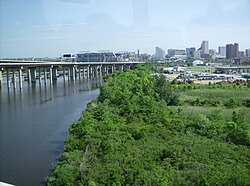Hanover Street Bridge

The Hanover Street Bridge – officially, the Vietnam Veterans Memorial Bridge – is a bascule bridge crossing the middle branch of the Patapsco River along Hanover Street (Maryland Route 2) in Baltimore, Maryland. The bridge was built to replace the mile-long "Long Bridge" built by Richard Cromwell in 1856 to move products from his orchard in Anne Arundel County to downtown Baltimore.The Hanover Street Bridge connects the southern base of the industrialized South Baltimore to the neighborhood of Cherry Hill and Brooklyn. The bridge carries five lanes of traffic: two northbound, two southbound, and one reversible. It employs a lane control system and carries two sidewalks on either side. Designed by J. E. Greiner Company, the bridge was constructed in 1916 and is characterized as a Beaux Arts-style reinforced cantilever bridge. It is known for its beautiful arches as it spans the water. In the center of the bridge is a drawbridge span surrounded on four corners by classic style towers which lend it a distinctive appearance. The bridge is 2,290 feet (700 m) long. On May 30, 1993, Baltimore Mayor Kurt Schmoke officially renamed the bridge the "Vietnam Veterans Memorial Bridge". In the 1990s, the area under the bridge became the site of a rough and sometimes murderously violent "tent city" campsite for the homeless.As of January 2016, the bridge is in a state of disrepair, riddled with numerous potholes – some exposing the rebar below.
Excerpt from the Wikipedia article Hanover Street Bridge (License: CC BY-SA 3.0, Authors, Images).Hanover Street Bridge
South Hanover Street, Baltimore
Geographical coordinates (GPS) Address External links Nearby Places Show on map
Geographical coordinates (GPS)
| Latitude | Longitude |
|---|---|
| N 39.257777777778 ° | E -76.616277777778 ° |
Address
Hanover Street Bridge
South Hanover Street
21230 Baltimore
Maryland, United States
Open on Google Maps






